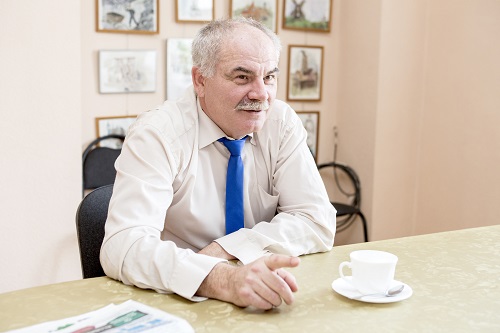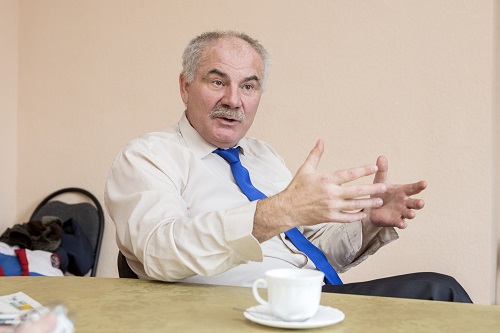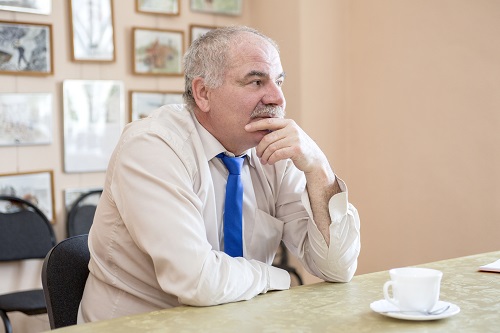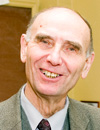 |
||
|
The Do-All Accelerator AtomInfo.Ru, PUBLISHED 23.03.2016 Oleg GRUDZEVICH, Deputy Director General - Director of the Advanced Research Department, "SSC RF - IPPE", answered the questions of the AtomInfo.Ru on-line newspaper. CONTINUED BELOW Oleg Grudzevich, (c) IPPE, Serguey Stozhilov  Joint Work Oleg Teofilievich, in December 2015 the Tandetron accelerator was put in operation at the IPPE. Yes, indeed, together with the Dutch specialists, we performed the startup of a new accelerator, and that is an event significant for our Institute. Before getting into the talk about the plans of its future use, I would like to stress a minor but interesting point. It happened so that the 50-th anniversary of one of our Dutch colleagues, Martin Bos (you can find his picture in our accelerator startup coverage), fell on his business trip to Russia. So, for Martin his trip to Obninsk became essential for two reasons: the successful startup of the accelerator and a milestone in his life. What is your impression of the joint work with the colleagues from the Netherlands? They are very knowledgeable and competent experts who know their equipment very well. Let me quote an example. As soon as a continuous beam was generated, the next step was to test the operation in the pulse mode. It was necessary to make sure that the required parameters are maintained, i.e. duration of 2 nanoseconds and so on. In the morning the decision was made to start testing the mode. Two hours later everything was done: we obtained 2 nanoseconds, and by the lunch time it was 1.2 nanoseconds. Were these tests performed jointly? Successively. First, by the engineers from the supplying company, and right after that by our specialists. Describing the work on the accelerator setup on the whole, I can say that it went on in a well-trodden way. The final commissioning of the system will be in March, and before that, in compliance with the Contract terms and conditions, we cannot operate it independently, by ourselves. How complicated is the accelerator in terms of its control? It has simple and well-considered control. Do you need to connect a gas system? Welcome, one click of the PC mouse is enough to preset the pressure. Is the beam cut off? Five seconds and the doors are unlocked. Actually, no problems are expected. Are your specialists ready to operate the Tandetron? I believe, yes, they are. The fate of accelerators Oleg Teofilievich, last year our website published the information about other IPPE accelerators. What is in store for them after the Tandetron startup? Besides the Tandetron, four more accelerators are in operation at the IPPE. Two of them, namely: EG -1 and EG-2.5, will be decommissioned in 2017. These are the very first accelerators that appeared at the IPPE. As our long-term employees affirm, the EG-1 accelerator was designed in the Physical and Technical Department of Kharkov University and was fabricated in Leningrad, at the NIIEFA, by Kurchatov's personal order. The specific decommissioning program is envisaged under Rosatom financial support. Both accelerators are covered by this program. So far we are at the stage of paper work. Then a radiation survey will be held in the rooms as the accelerators have been in operation for many decades, with neutrons and beryllium used as well. Then there will be a few other stages and at the end there will be the stage of equipment dismantling and removal. This stage is the simplest one as all the required equipment and tools are already available and in place, namely: cranes, gates and so on... That would be a pity to lose such a remarkable and historical fleet. We wouldn't like it either. Two accelerators will be decommissioned. And the two others? They will keep working. The KG-2.5 accelerator is high-current and we are planning to use it for combined irradiation. What is the main problem of structural material radiation resistance? Radiation results not only in displacement of atoms but also in generation of gas products, first of all, they are hydrogen and helium. Thus, in order to, at the most, make the simulation studies of steels at the accelerator closer to irradiation conditions at reactors, triple-ion irradiation is used abroad, i.e. simultaneous irradiation with heavy ions (chromium, iron or nickel), helium and hydrogen. By the way, right before our meeting, I was reading an article where it is stated that on the territory of the former USSR the triple-ion irradiation is used in Kharkov. The combination for triple-ion irradiation is selected on the basis of calculations, through determination of the amount of helium and hydrogen generated in reactor steels in the course of neutron irradiation. These types of calculations are not considered the most complicated. We plan to use KG-2.5 together with the Tandetron for double irradiation. Our predecessors did their utmost to make this task easier for us, as the beams are extracted into one target room. The decision was caused by other reasons, but this setup proved to be fortunate for us. Otherwise we would face the necessity to build a common target room - and I can't even imagine how much it would cost to the Institute. But the combined irradiation will be double, not triple? Yes, at this point only double. The Tandetron will provide heavy ions - whatever types we require - and KG-2.5 will produce hydrogen. KG-2.5 does not accelerate helium, but we can take helium from the Tandetron. The problem of transferability of the results to reactor conditions is always a concern and it will remain topical both for double and for triple irradiation. I think that the English term "simulation" better describes the essence of accelerator experiments with steels. What we do at the accelerator is simulate, rather than imitate, the conditions of steel working inside the reactor. For one thing, the probability of interaction between a neutron and a nucleus is evaluated in barns, and for heavy ions - in kilobarns. However, this difference has its benefit: by turning from barns to kilobarns we get a better rate of destructive dose accumulation by the irradiated sample. It takes years to get the dose of 100 dpa in the reactor. Our system makes it possible to get the same dose in weeks. And what if the required doses are 200 or 300 dpa, as it is the case now? Of course, accelerators alone are not enough to solve the problem of selecting radiation-resistant steels with the required parameters. I think the best word to describe what we really do in this regard is "sorting out." If the material does not withstand irradiation with heavy ions, it will definitely not withstand neutrons. In other words, if you rejected the material following the accelerator experiment results, then there is no point to irradiate it at BOR-60? Exactly. That is to say, we undertake preconceptual studies and thus save the expensive and scarce reactor time. Following our research, we are able to recommend certain steels for more detailed studies in reactor experiments. Speaking in elementary terms... You would not build a staircase of rotten planks, would you? First, you will examine the planks and select the strong ones. Our participation in material studies is similar to the stage of plank examination. The fourth operating accelerator is EGP-15. EGP-15 accelerator, our glory. This machine has one fundamental advantage over the majority of other accelerators in Russia: it has high energy. However, there is a drawback there, too. It has very high operating costs. Just to make it clear, EGP-15 team consists of 5 people. There is a demand for the operation of EGP-15. On the one hand, these needs arise in the sphere of science, on the other hand - in the sphere of technology. For example, 15-MeV protons can be used to simulate cosmic processes, to study electronic equipment for its durability in space. Such protons can also be used to irradiate semiconductor wafers for power electronics. Actually, it is not only possible, but essential. And this is accomplished in Russia. But at the same time, we should pay special attention to the issue of economic effectiveness. In conclusion. The EGP-15 accelerator is in operating conditions and that is how it will remain. We have people. Should we obtain specific orders, we will complete them.  Accelerator for PET Next question. How does the Institute plan to use the Tandetron? I have already mentioned one task: studies of structural material behavior under irradiation. It is not a new field for us; we have the experience of EGP-15 experiments. Therefore, we will continue to irradiate steels at the Tandetron after the new machine is commissioned. There is another task, which we have never dealt with, but which Tandetron is very well tailored for, that is production of radioisotopes for positron-emission tomography, PET. Which isotope do you mean? Fluorine-18. It is ideal for PET needs. It has relatively short half-life, 109 minutes, and sufficiently low energy. Is fluoride-18 produced in Russia? The situation is as follows. As a rule, the whole system is supplied, the PET scanner. It comprises a cyclotron- accelerator producing the isotope for the specific system. There is also a gamma-radiation sensor, a radiochemical set for pharmaceutical manufacturing, and a syringe for injections. The operating principle of the PET scanner should be clear to any physicist. During decay, the fluoride-18 isotope emits a positron that collides with an electron. It results in annihilation and two gamma-quanta, 511 keV each. Gamma radiation is detected with a gamma sensor and computer software is used to make out a diagnosis to the patient. The cyclotron costs approximately half of the whole system. By the way, why was the cyclotron chosen for PET purposes? Because it is small. What is the problem of the cyclotrons integrated with the PET sets? They produce not the best-quality fluorine. Unfortunately, side reactions take place resulting in impurity generation. Whereas we need only one reaction, more specifically the (p,n) reaction in oxygen-18. The Tandetron is able to help medical workers in resolution of the problem of impurities in fluorine. We can accurately adjust energy at this machine, and it makes it possible to get rid of impurities in the isotope produced. Our participation could be as follows. We produce fluorine-18 at the Tandetron, in the neighboring building radiochemical operations are performed, and then the obtained sample is delivered to Kaluga by car. It should be reminded that its half-life period is 109 minutes - i.e., during transportation to Kaluga the activity will drop no more than by half, and it is quite acceptable. According to our estimation, we will be able to build up activity as high as dozens of doses per hour of Tandetron operation. How much will this task be in demand? It is a good question. On the one hand, the medical workers assert that there are enough PET-scanners in the country. On the other hand, people queue up for the survey with their application. Currently we are concerned with two things. It is necessary to assess the situation and understand how much our fluorine-18 is in demand in the domestic medicine. At the same time, we must try out all technical aspects in order to expressly understand - we work for that long time span and deliver to the consumer that much activity. And, as a matter of fact, in addition we will have to take a gamma-spectrometer with the resolution of 1 keV and measure what our fluorine-18 will contain. Then we will be able to talk to our medical workers with the spectra in hand: "Here is our post-irradiation fluorine, and here it is two hours after transportation, and here are the impurities." While you are transporting the fluorine to Kaluga, the impurities will decay. They will decay in the ideal case. It may well happen that some long-lived "dirt" might be present in the fluorine by our technology. However, this is a task for radiochemists how to separate it. Are the medical workers aware of your proposals? Yes, they are. Late in January at the IPPE we gathered together all potential consumers of our beam. The first day was dedicated to the issues of structural materials' studies, and the second day - to the discussions of the topics of radioelectronics and medicine. We found the areas of common interest. It will be followed by the discussion of specific cooperation matters, but this is already the level of the Director General of the Institute. Neutron Capture Therapy And what about neutron capture therapy? It's a very promising area. It's clear that it is not absolutely new for our Institute, the similar work used to be done at the BR-10 at some time in the past, by the way, on a grand scale, with hundreds of patients subject to treatment. Our Obninsk medical specialists quote impressive data on the results. The post-treatment survival rate ran to 10%, as far as I remember correctly. This value is tremendously high for the last-stage cancer. However, you'd better discuss this subject in detail with medical specialists. Neutrons are generated directly in the reactor. The accelerator does not produce neutrons. Thus, we need to get them one way or the other. In this case, any reactions, (p,n) or (d,n), will do. No doubt, it is more expedient to generate them with a light nucleus. Lithium-7 is a good choice as a target. Technical problems will surely be encountered. A lot of neutrons are required, and a beam carries energy. If you mindlessly start applying high currents to the lithium target, it will be melted through. To be more precise, you will melt a hole in the target, where the proton or deuton beam will uselessly go. At the KG-2.5 accelerator, under Victor Nikolayevich Kononov's supervision, the technology was developed that allowed the problem of heat removal from the target to be solved in the elegant way. Let us summarize. Protons and deutons are available; the targets are in place, heat is removed, energy is sufficient. And there is only one technical problem left - unfortunately I can't mention it, as it involves disclosing the know-how. But we will certainly solve it. And there it is. From the technical point of view, we'll be ready for neutron capture therapy. Strictly speaking, a room for irradiation will have to be also arranged, but it's not a great challenge. Unfortunately, besides the technical aspects there is some paper work to be done. It takes time to implement new technologies into medical practice, and sometimes it comes to years. These are the rules. You are welcome to conduct experiments with rats or mice, but as soon as the issue concerning people is raised... We have very serious intentions to implement neutron capture therapy at the Tandetron and we'll do our best to achieve this goal. By the way, when I told Martin and his colleague Robert about the fact that the accelerator they were mounting at the IPPE would work for public health, they were proud to hear the news. I would like to say again that there are no insuperable technical obstacles for that. There are organizational issues, paper issues and we need time to solve them. We have already covered part of the way with КG-2.5, when the beam and the target were certified. And it was used for real irradiation - naturally of rats only. I would like to remind that back in the day at the IPPE the "Elegy" project was developed; that was a system consisting of a commercial electron accelerator with a size of a writing desk and a gallium target. Hence the name "Electrons and Gallium" consonant with "Elegy." Andrei Aleksandrovich Goverdovski was the Project Leader at that time, and you'd better address him for more details. The only thing I would like to mention in this context is that the melting point of gallium is below 30 degrees - i.e. it melts in hands. The Project was justified and supported with calculations and then with the experiments both here and in Dubna. At the target outlet, there were neutron spectra of the required quality. Probably in the future we'll have to come back to the Project for the needs of neutron capture therapy. Thank you, Oleg Teofilievich, for your interview for the AtomInfo.Ru on-line newspaper.  Topics: Interview Other news: 443 nuclear units are operating in the world Another 65 units have the status of the being built one. New American submarine will be named after admiral Rickover 60th anniversary of the first trip of the nuclear submarine Nautilus. Westinghouse will deliver CE16NGF fuel on Palo Verde This is a new generation fuel for 16×16 grid. |
Hero of the day 
Rudolf Baklushin: BN-350 collected experience The reactor facility BN-350 is the first facility with the fast neutron reactor. Experience of its designing, building, installing and exploitation has helped to realize and solve many problems with NPPs of a fast sodium type. INTERVIEW
Lev Kochetkov OPINION
Drones over France - the neverending story |

